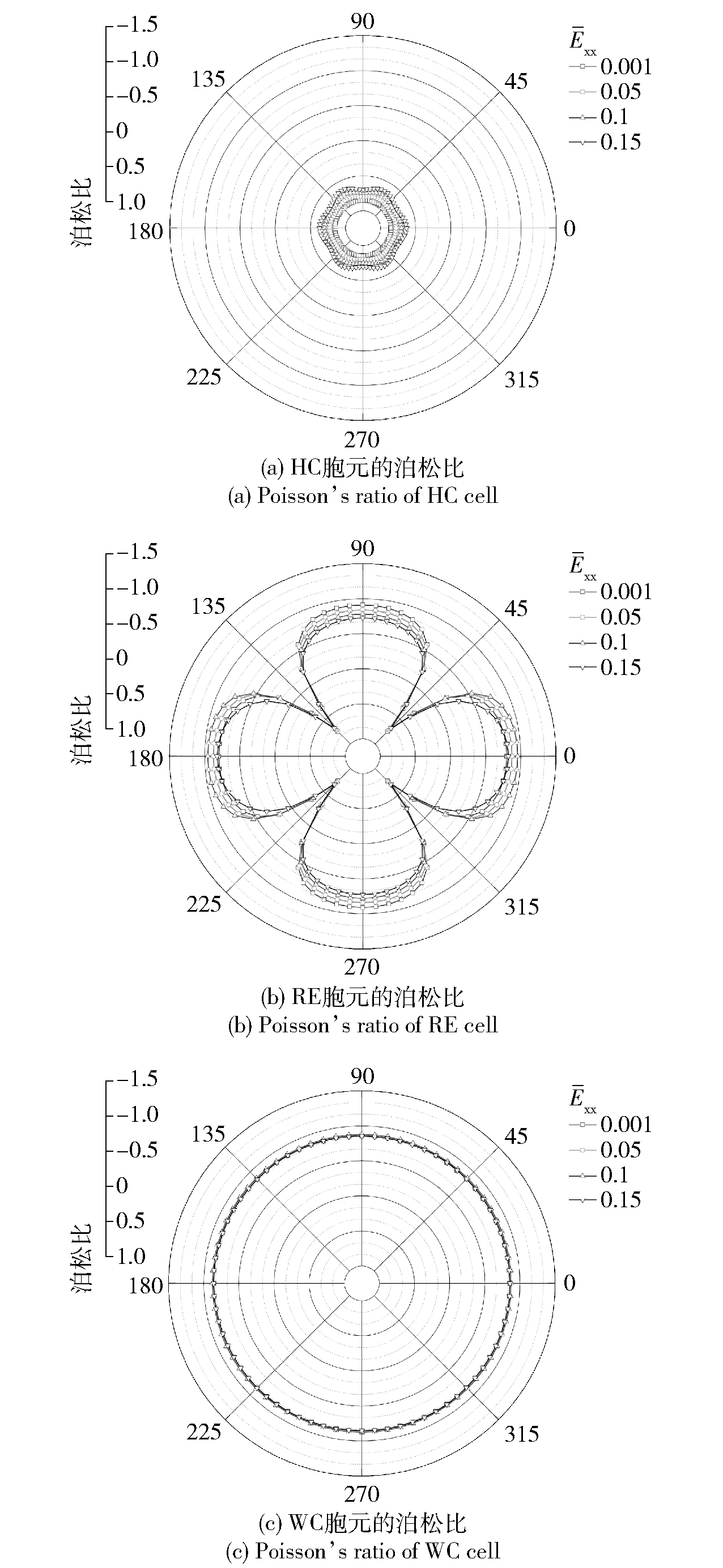


主管单位:中国科学技术协会
主办单位:中国兵工学会
ISSN 1000-1093 CN 11-2176/TJ
主办单位:中国兵工学会
ISSN 1000-1093 CN 11-2176/TJ



兵工学报 ›› 2025, Vol. 46 ›› Issue (10): 250507-.doi: 10.12382/bgxb.2025.0507
收稿日期:2025-06-16
上线日期:2025-11-06
通讯作者:
基金资助:
YANG Chenchen1, LIU Jun2, HAN Fanghao3, MEI Yue2,4,*( )
)
Received:2025-06-16
Online:2025-11-06
摘要: 负泊松比结构因其拉胀变形行为,在冲击载荷下展现出优异的能量分散与应力均匀化能力,在军事防护领域具有广阔应用前景。然而,传统网格类数值方法(如有限元法)在模拟大变形时易因网格畸变导致计算精度下降甚至中断。采用物质点法系统研究了三种典型胞元(正六边形蜂窝、内凹六边形和波浪形手性)夹层结构在冲击载荷下的动态响应与能量耗散机制,并通过网格独立性检验和实验验证,证实该方法具有良好的网格收敛性与物理保真度。结果表明,负泊松比结构抗冲击性能显著优于常规结构:相较于正六边形蜂窝结构,内凹六边形和波浪形手性结构的峰值反力分别降低27.9%和61.9%。机理分析表明,波浪形手性结构通过“环链旋转-韧带延展-孔隙闭合”的多级耗能机制,促使能量沿胞元网络均匀耗散,从而有效抑制应力集中与结构失效。本研究为舰艇防爆、单兵装甲等防护装备的轻量化抗冲击设计提供了理论依据与仿真工具。
杨晨琛, 刘骏, 韩芳灏, 梅跃. 基于物质点法的负泊松比胞元夹层结构动态冲击响应及能量耗散机制[J]. 兵工学报, 2025, 46(10): 250507-.
YANG Chenchen, LIU Jun, HAN Fanghao, MEI Yue. Research on Dynamic Impact Response and Energy Dissipation Mechanisms of Auxetic Metamaterial Sandwich Structures with Negative Poisson’s Ratio Based on Material Point Method[J]. Acta Armamentarii, 2025, 46(10): 250507-.
| 参数 | 数值 | 参数 | 数值 |
|---|---|---|---|
| E/GPa | 210 | D1 | 0.50 |
| ν | 0.3 | D2 | 3.44 |
| ρ/(kg·m-3) | 7850 | D3 | -2.12 |
| cp/(J·kg-1·K-1) | 450 | D4 | 0.002 |
| A/MPa | 265 | D5 | 1.09 |
| B/MPa | 300 | c/(m·s-1) | 5172 |
| n | 0.31 | S1 | 1.49 |
| ${\stackrel{·}{\epsilon }}_{0}$/s-1 | 0.00001 | S2 | 0 |
| C | 0.014 | S3 | 0 |
| Tr/K | 293 | γ0 | 1.8 |
| Tm/K | 1795 | E0/(J·m-3) | 0 |
| m | 1.03 |
表1 Q235钢的材料模型参数[22]
Table 1 Material model parameters of Q235 steel
| 参数 | 数值 | 参数 | 数值 |
|---|---|---|---|
| E/GPa | 210 | D1 | 0.50 |
| ν | 0.3 | D2 | 3.44 |
| ρ/(kg·m-3) | 7850 | D3 | -2.12 |
| cp/(J·kg-1·K-1) | 450 | D4 | 0.002 |
| A/MPa | 265 | D5 | 1.09 |
| B/MPa | 300 | c/(m·s-1) | 5172 |
| n | 0.31 | S1 | 1.49 |
| ${\stackrel{·}{\epsilon }}_{0}$/s-1 | 0.00001 | S2 | 0 |
| C | 0.014 | S3 | 0 |
| Tr/K | 293 | γ0 | 1.8 |
| Tm/K | 1795 | E0/(J·m-3) | 0 |
| m | 1.03 |
| 参数 | 数值 | 参数 | 数值 |
|---|---|---|---|
| E/GPa | 70 | D1 | 0.01241 |
| ν | 0.3 | D2 | 1.607 |
| ρ/(kg·m-3) | 7850 | D3 | 4.133 |
| cp/(J·kg-1·K-1) | 450 | D4 | -0.01377 |
| A/MPa | 205 | D5 | 1.302 |
| B/MPa | 1064 | c/(m·s-1) | 2986 |
| n | 0.5085 | S1 | 1.49 |
| ${\stackrel{·}{\epsilon }}_{0}$/s-1 | 0.00001 | S2 | 0 |
| C | 0.02846 | S3 | 0 |
| Tr/K | 293 | γ0 | 1.8 |
| Tm/K | 1623 | E0/(J·m-3) | 0 |
| m | 0.662 |
表2 用于3D打印的316L不锈钢材料模型参数[23]
Table 2 Material parameters of 316L stainless steel used for 3D printing
| 参数 | 数值 | 参数 | 数值 |
|---|---|---|---|
| E/GPa | 70 | D1 | 0.01241 |
| ν | 0.3 | D2 | 1.607 |
| ρ/(kg·m-3) | 7850 | D3 | 4.133 |
| cp/(J·kg-1·K-1) | 450 | D4 | -0.01377 |
| A/MPa | 205 | D5 | 1.302 |
| B/MPa | 1064 | c/(m·s-1) | 2986 |
| n | 0.5085 | S1 | 1.49 |
| ${\stackrel{·}{\epsilon }}_{0}$/s-1 | 0.00001 | S2 | 0 |
| C | 0.02846 | S3 | 0 |
| Tr/K | 293 | γ0 | 1.8 |
| Tm/K | 1623 | E0/(J·m-3) | 0 |
| m | 0.662 |

图4 三种胞元构型的压缩泊松比极坐标图(左侧坐标轴代表有效泊松比,右上角Exx表示平均Biot应变)
Fig.4 Polar plots of the compressive Poisson’s ratio for three cell configurations (Left axis represents the effective Poisson’s ratio; Exx denotes the average Biot strain)
| 算例 | 背景网格尺寸 | 单个网格粒子数 | 粒子总数 |
|---|---|---|---|
| 网格1 | 1.25×1.25mm2 | 2×2 | ~3.83×103 |
| 网格2 | 1.00×1.00mm2 | 2×2 | ~5.98×103 |
| 网格3 | 0.50×0.50mm2 | 2×2 | ~23.94×103 |
表3 含不同背景网格尺寸的三组算例
Table 3 Three cases with different background mesh sizes
| 算例 | 背景网格尺寸 | 单个网格粒子数 | 粒子总数 |
|---|---|---|---|
| 网格1 | 1.25×1.25mm2 | 2×2 | ~3.83×103 |
| 网格2 | 1.00×1.00mm2 | 2×2 | ~5.98×103 |
| 网格3 | 0.50×0.50mm2 | 2×2 | ~23.94×103 |
| [19] |
|
| [20] |
|
| [21] |
|
| [22] |
辛春亮, 薛再清, 涂建, 等. 有限元分析常用材料参数手册[M]. 北京: 机械工业出版社, 2020.
|
|
|
|
| [23] |
王宇新. 爆炸冲击动力学数值分析物质点法[M]. 中国建筑工业出版社, 2014.
|
|
|
|
| [24] |
|
| [25] |
|
| [26] |
|
| [27] |
|
| [28] |
|
| [1] |
蒋伟忠, 张毅, 朱一林, 等. 功能性负泊松比超材料研究进展与展望[J]. 应用力学学报, 2025, 43(3): 494-510.
|
|
|
|
| [2] |
|
| [3] |
|
| [4] |
杨德庆, 马涛, 张梗林. 舰艇新型宏观负泊松比效应蜂窝舷侧防护结构[J]. 爆炸与冲击, 2015, 35(2): 243-248.
|
|
|
|
| [5] |
吴文旺, 肖登宝, 孟嘉旭, 等. 负泊松比结构力学设计、抗冲击性能及在车辆工程应用与展望[J]. 力学学报, 2021, 53(3): 611-638.
|
|
|
|
| [6] |
贺锋, 梁一鸣, 李季, 等. 异型陶瓷负泊松比复合结构的防弹防爆性能数值模拟研究[J]. 安全与环境学报, 2024, 24(8): 2919-2928.
|
|
|
|
| [7] |
廖瑜, 蒋新生, 田镇华, 等. 泡沫铝弹冲击下柱面负泊松比蜂窝夹芯结构防护钢板动态响应特性[J/OL]. 兵工学报, 2025: 1-14. DOI: 10.12382/bgxb.2025.0025.
|
|
|
|
| [8] |
庄晟逸, 李成伟, 向文超, 等. 负泊松比结构的改进设计及其在航空航天中的应用[J]. 化工学报, 2024, 75(11): 3951-3972.
|
|
|
|
| [9] |
|
| [10] |
|
| [11] |
金泽华, 刘清洋, 马文朝, 等. 新型星形负泊松比抗冲击结构设计与入水冲击[J]. 兵工学报, 2024, 45(5): 1497-1513.
|
|
|
|
| [12] |
|
| [13] |
|
| [14] |
|
| [15] |
|
| [16] |
|
| [17] |
|
| [18] |
|
| [1] | 毛光辉, 王成, 王万里, 徐文龙. 变形可控内凹蜂窝结构抗冲击性能研究[J]. 兵工学报, 2025, 46(3): 240037-. |
| [2] | 常人九, 薛晓春, 余永刚. 计及动态冲击挤进过程的埋头式弹药内弹道特性[J]. 兵工学报, 2022, 43(9): 2388-2398. |
| 阅读次数 | ||||||
|
全文 |
|
|||||
|
摘要 |
|
|||||
 京公网安备11010802024360号 京ICP备05059581号-4
京公网安备11010802024360号 京ICP备05059581号-4